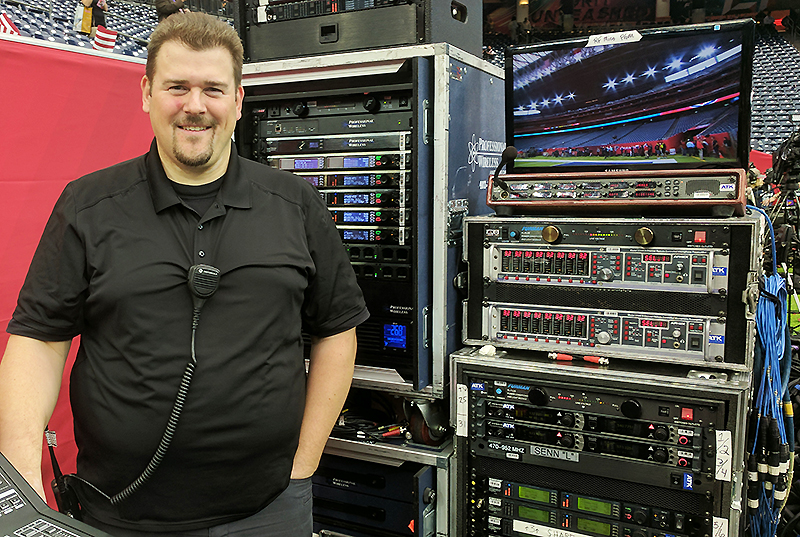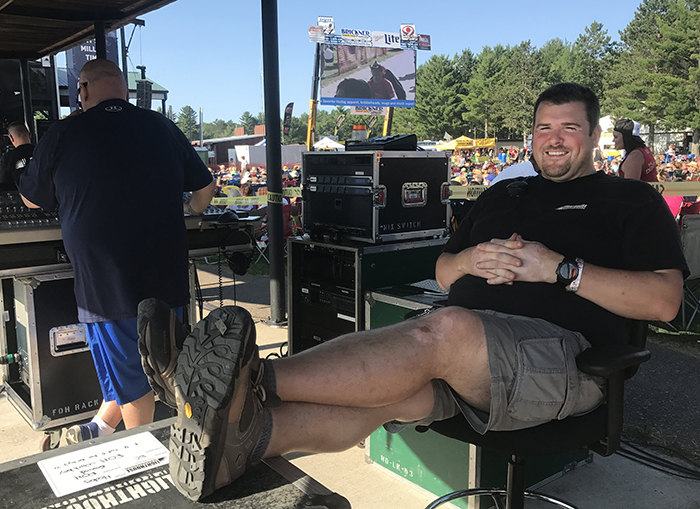
Additionally, it’s a bit lower in terms of pressure. That said, he stresses that regardless of the event, reliability is key, and providing it depends heavily on having a good team and a flexible plan. “For the Super Bowl there are many redundancies in place, but it’s not just about redundancy, it’s about going through what happens if any system fails. We don’t want it to, but we’ve always got a contingency.”
As an example, Trenda cites the 2018 halftime show, during which Justin Timberlake used a single handheld microphone while performing in multiple locations in the stands and on the field. “The question was how to deploy a system to cover the entire area with some amount of redundancy,” Trenda explains. “We used a handheld microphone broadcasting on two separate RF carriers simultaneously and placed antennas in various locations. Some of it was over coaxial and some over fiber optic cable coming back to our receivers. We were always picking up the transmission on at least two antennas and if we experienced interference on one frequency, we could remotely adjust the frequency experiencing interference. So, we could go from two transmissions to one, then back to two, and maintain redundancy.”
When I ask if anything has gone catastrophically wrong during similar, high-profile and high-stress gigs, he chuckles and says: “I’ve been fortunate. I’ve had things break during rehearsal and fixed them, but no major failures on air, which is maybe why they keep asking me back.”
Changing Times
Over time, however, as the amount of real estate available in the wireless landscape shrinks, the job is becoming far more challenging, he continues: “When I started we had from 470 MHz to 806 MHz in the UHF TV band. There are other bands we operate wireless in, but that was where the bulk of our systems operated. In the early 2000s we lost a little over 100 MHz of spectrum, so it became more difficult to make high channel-count shows work in the UHF band.”
And since the most recent spectrum selloff: “Our UHF television broadcast happens between 470 to 608 MHz – in just over 100 MHz of spectrum – so we’re having to do a lot more pre-planning. You’ve really got to think about how to fit your equipment in with everybody else. We need to specify equipment in appropriate frequency bands, to find open UHF and VHF spectrum and/or alternate frequency bands. Anything that’s available we try to utilize.”
These challenges are being addressed, he says, by various technologies, including newer digital microphone systems, which provide more channels over less bandwidth, but other increasingly efficient technologies are also promising. “We used to have wireless intercom systems that, like wireless microphones, ate up a lot of frequencies,” he says. “Newer systems multiplex users, within a digital channel that’s 2 MHz wide, you can multiplex ten intercom users. Microphones and IEMs probably won’t be as spectrally efficient because they require higher bandwidth and lower latency, but I think that’s an indication of where they’re able to go with digital technology.”
Any solutions adopted to address ongoing challenges in the deployment of wireless equipment will need to keep pace with the growing demand for fan engagement by those attending live events and watching them remotely. “My experience with football, particularly the Green Bay Packers, is they’re very concerned about the fan experience,” he notes. “Live, it has to compete with what people get at home in terms of replays, audio from the field, and high-quality reinforcement of what’s happening during and between play. At a Packer game, for example, there’s a drum line performing between quarters. All those production elements require wireless microphones, intercom and cameras.”
Another issue he points to is the increasing reliance on stadium Wi-Fi to deliver content to viewer’s personal devices. “That’s one more place we can’t put other wireless devices and our systems need to be more robust because of outside interference and strong adjacent signals that may cause interference. It’s all making it harder to operate reliably.

“Maybe what makes me well suited for these sorts of events is that I tend to be pretty even-keeled about potential problems,” he continues. “But it’s also about the people I work with and the larger community of RF technicians. If there’s something I don’t know, my phone-a-friend option is always good and vice versa. I can be a resource to people for particular applications that maybe I’m better versed in than they are.”
Larger Concepts
Being that resource is ultimately where Trenda sees his career path leading. “I already do a lot of training through PWS and I really enjoy teaching. As I go on in my career, I’ll probably do more on the educational side. There’s a definite need for bringing people up, and a demand for them, because you need to hire someone who has in-depth knowledge of RF equipment to get a high channel count to work at your event.
“Going forward I’d like to get more people involved and interested in this side of the business. There are a number of interesting, winding roads people take to become higher-level audio and RF techs. And when I was in college, I had no idea a technical background could lead down this sort of career path.”
Given his experience, he’s well suited to help others find their way along that path. “It’s kind of the ‘teach a person to fish’ approach,” he concludes. “I want to teach people the larger RF concepts so that it doesn’t matter what technology they’re using, or how big an event is, they’ll understand the fundamentals and have a better chance at having a system that’s deployed correctly and a show that runs reliably.”
